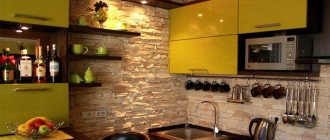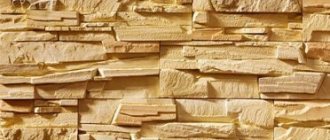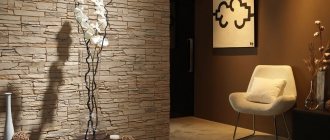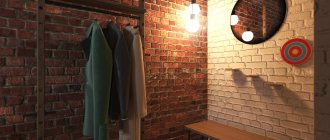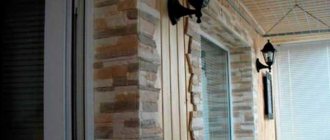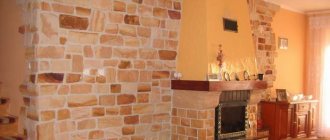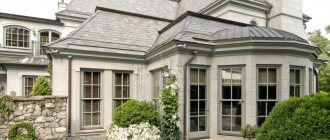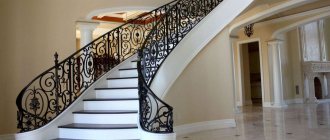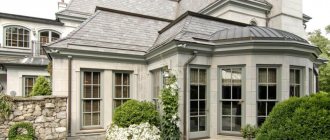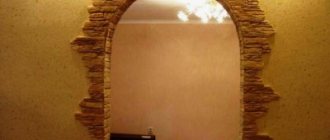11.04.2018 0
5796
Not every owner of an apartment or house can afford to decorate the interior with expensive natural stone. A budget analogue to natural material will be various wallpapers that imitate marble, granite, pebbles, and tiles. Find out how to choose the right coating and use it to decorate different rooms.
About the advantages and disadvantages
The advantages of finishing include:
- harmony with any style;
- a huge range of textures, shapes and colors;
- originality;
- easy maintenance and long service life;
- decorating walls in this way will not be difficult;
- the stone is not susceptible to infection by fungal growths;
- environmental friendliness;
- light weight.
Cons of artificial stone:
- shorter service life compared to natural materials;
- some samples made of soft material quickly take on a shabby appearance;
If you correctly select this decorative element, then the listed shortcomings will remain in the shadows. To protect it from negative environmental influences, its surface is treated with a special impregnation or varnished.
No. 2. Decorative plaster
Decorative plaster allows you to create quite an interesting and unique finish: thanks to different compositions and fillers, you can get a smooth shiny surface (Venetian plaster) or a textured one. In addition to interesting decorative effects, plaster is often used in hallways due to other advantages:
- solidity of the finished coating;
- environmental friendliness and breathability;
- strength, durability and wear resistance, because scratching such walls will not be easy;
- antistatic and easy to maintain;
- It is not necessary to prepare the surface of the walls for plastering as carefully as for painting, because the solution can fill small holes and hide minor defects.
Combining artificial stone with wallpaper
Decorative stone is unique in all respects, and any type of wallpaper will harmonize with it. To ensure they last a long time, you should choose high-quality fabrics. Liquid wallpaper is perfect for the hallway.
You can also use paper, non-woven or glass wallpaper.
Paper material is cheap, easy to stick to walls, and can be painted well.
Non-woven wallpaper has a porous structure, making it easy to hide any unevenness or cracks. They are also durable and can withstand staining well.
Fiberglass wallpaper combines favorably with decorative stone, as it has a relief surface.
Photo wallpapers will look good. It is important that they match the selected stone as closely as possible.
Fashionable colors of marble: white, beige, black and gray
In the photo: The interior of a long corridor decorated in black and white colors in the Art Deco style
Among the fashionable shades of marble, the most popular in design are white, beige, black and gray. What made them trendy is their versatility - they are used in almost any style of interior design and go well with both traditional wooden furniture and other fashion trends.
Below we will look at various options for marble in the interior based on tiles and porcelain stoneware with a marble pattern, which are the most practical solution for finishing apartments and private houses.
Luxurious Art Deco style hall design with black marble and metal inlay
In the photo: Interior design of the hallway and corridor in beige tones with gold accents
Marble in the interior always looks luxurious. But black marble is one of the most unique options when it comes to adding luxury to your interior. Such marble in the interior of a bathroom or kitchen looks not just elegant, but also luxurious. This finishing solution goes well with dark furniture, white marble, and geometric accents. Tiles with a marble pattern in the interior with inserts and geometric patterns look even more exclusive. A marble countertop (made of marble-like quartz agglomerate or corian) in the kitchen will also look very impressive. By the way, black marble is most often used in the design of the floor in the hall and hallway, as well as the kitchen apron and accent blocks against the background of white marble finishing.
Bathroom with Art Deco elements and white marble porcelain tiles
In the photo: Bathroom interior in white marble with gray veins. Photos of 2022
White marble is the most popular solution for decorating a room in any style. It can be found in minimalism and Scandinavian, neoclassical and even loft. White marble has a large number of imitations: the best for such finishing would be large-format marbled porcelain stoneware or tiles. There are also options for wallpaper and flexible marble, Venetian plaster with stone pattern and countertops.
Beige marble and copper-look tinted glass for wall decoration in the bathroom
In the photo: Small bathroom in warm colors with porcelain tiles
Beige marble can most often be found in classical interior styles: baroque, rococo, classicism, Victorian style and the like. It is often used to decorate country residences and mansions. In addition to the standard use in the design of floors and walls, you can decorate the window sill, stairs, exterior, decorative niches and even the ceiling with marble. Sometimes beige marble is combined with travertine, sandstone and onyx, especially in the decoration of country houses. Various combinations are found in hotel and restaurant design.
Brown marble in the design of the floor in the hallway and corridor with an emerald accent
In the photo: Beautiful renovation of the hallway and corridor in warm colors with a built-in wardrobe and ottoman
Brown marble is a unique shade that is most often used in styles such as classicism, art nouveau, and American classics. It goes well with traditional wood, as well as with fashionable deep accents in textiles and decor (emerald, marsala, malachite, midnight blue, purple and others).
Gray and dark gray marble in the finishing of the shower area and jacuzzi
In the photo: Bathroom renovation with a podium for a jacuzzi
Gray or white-gray marble is now a fashionable hit of the season. If black, white and beige have always been popular, then cold shades of gray stone have long been used for decoration only in special cases. Nowadays, most styles in interior design love grayish shades: Scandinavian, minimalism, neoclassicism, art deco, eclecticism.
Gray quartzite is also trending, which from a certain angle and without observation can resemble marble. Quartzite is good because its color range is much wider than that of marble, so you can find almost any shade, even the most complex. Imitations of quartzite in porcelain stoneware are also very original. The most popular line of marble in gray shades is the Italian stone from the Calacatta quarry. In the original, 20 mm thick slabs cost approx. 30,000–40,000 ₽/m², and Italian porcelain tiles with this pattern are already about 5,000–10,000 ₽/m².
Color solutions
Most often, beige, gray or brown shades are used in modern hallway design.
To visually enlarge the space, use light shades that imitate marble, granite, quartz or pebbles.
It is better to choose light wallpaper for a dark stone finish.
The best option would be if the wallpaper is two shades lighter than the stone.
Various bright colors are also relevant.
Kinds
Before considering this or that type of plaster for cladding and decorating a hallway, it would be a good idea to visually classify it by type and type.
According to the type of purpose, decorative plaster is divided into two types:
- Facade. This type of material is used for cladding buildings and has a dense structure. Most often it is toxic, so it is not used in residential areas. Facade plaster may contain granite or marble chips (mineral), have a “liquid glass” base (silicate), or consist of polymers or silicone.
- Interior. This type of plaster differs from façade plaster because it contains more gentle and less resistant substances.
According to the surface relief, decorative plaster can be:
Textured and smooth (rough surface, different textures, degrees of unevenness and application techniques). Heterogeneous granular mass of various shades based on synthetic materials. Granules of various origins are added to the composition of such plaster, depending on the purpose of the final result. This can be crumbs of natural and artificial materials (marble, sand), flax or cotton fibers, wood fiber. Based on the structure, the main types of textured plaster can be distinguished: bark beetle (imitation of traces of the bug of the same name, grooves in the material), fur coat, silk, rain and lamb (astrakhan).
The composition of Venetian plaster is a mixture of stone dust from the rock with which the final result is stated. In addition to marble grains, the mixture may contain quartz, lime, and granite. The finer the stone chips, the thinner and more natural the pattern.
Styles
The hallway creates the first impression of the home, and therefore it is very important to choose its design. Let's consider design options that use the “stone + wallpaper” duo.
Modern style . Chooses white stone to match the brick and light wallpaper.
Eco style . Slate rocks are used here.
Urbanism . Uses brick-like tiles.
Classic . Decorates the walls with marble or granite.
Country and Provence . They use gray and brown stones of different shapes. Combined with regular wallpaper, photo wallpaper and murals.
It is not uncommon to add “street lamps” to such an interior.
Types of stone wallpaper and features of their use
- Paper. The simplest, budget option with a short service life. This wallpaper is environmentally friendly, but bears little resemblance to the original due to its smooth surface.
- Vinyl. They are characterized by good durability and ease of care, since they can be washed. Thanks to the textured relief, from a distance they resemble real masonry.
- Photo wallpaper. Their surface is smooth, like paper wallpaper. But a bright, natural, very realistic pattern creates the illusion of natural marble, granite, brick, etc.
- Flexible stone wallpaper. The material will cost more than others, but it is well worth the price. To make this coating, a cut of sandstone or stone chips is used. They are applied to an elastic base (fabric, non-woven fabric), so the wallpaper can be rolled. Manufacturers skillfully imitate the texture and shade of real stones - even to the touch the material seems like real quartz or granite.
Attention! In addition, you can use decorative tiles or plastic panels with corresponding “stone” patterns.
Paper wallpaper is not suitable for the work area of the kitchen, bathroom, or hallway. They get dirty quickly and are not designed for wet cleaning. For all of these rooms, it's worth choosing more durable vinyl or flexible varieties that will last longer and still look great.
Designers do not recommend combining wallpaper with different “stone” patterns in the same room. It is better to combine them with other finishing materials, taking into account the purpose of the room.
Interesting ideas
So, let's see what we can do to unusually decorate the walls with decorative stone and wallpaper in the hallway?
- Apply jagged edges to make the walls look voluminous.
- Install spotlights to highlight the cladding.
- Add various decorations to the wall. Mirrors, paintings, fakes and compositions will be used.
- Create a living corner.
- In the classical direction, place stone on the columns, emphasizing the overall ambiance.
- Hang shelves to store small items.
Door jamb trim
If you want to finish the walls, the first row should be laid along the lath to align the cladding relative to the horizontal surfaces. Using a spatula, the adhesive is applied to the tile and distributed over the area. Excess mixture must be removed with a comb spatula.
In order to lay out the elements evenly, you should use a building level. Liquid nails can also be used to fasten elements. The mixture is also suitable for ceramic tiles. The first option should be purchased if you prefer cement-based stone.
The thickness of the applied composition should be 4 mm or less. The second line of stone when finishing the doorway is laid according to the principle of brickwork with bandaging of the seams. After completion of the work, the crosses or restrictive elements are removed from the seams. The latter should not be wider than 1 cm, in which case finishing the doorway with stone will look unaesthetic. Some types of cladding described are installed without seams.
Artificial stone on the arch
A popular option for using stone in the interior of a hallway is lining the passage to different rooms with stone. Using your imagination, you can choose the best option for yourself.
The decoration of the opening looks exclusive if the brick meets the wall in places.
The arch can be made in any color and style.
You can line one side of the passage with stone.
Or surround it with stones.
Marble finishing in the interior: porcelain stoneware, tiles, wallpaper (flexible marble), plaster
In the photo: Design project of a combined bathroom in white and black marble
Finishing with natural slabs is typical for luxury projects. For example, a slab looks impressive on an accent area in the living room. There are two options: slabs, shaped like tiles, combined together, or machiaparte (machbook, butterfly), when two slabs from a rock layer turn towards each other, creating an interesting visual effect similar to the wings of a butterfly. To replace expensive slab finishing, flexible marble or marbled Venetian plaster is often used.
Interior design of a modern bathroom with white marble porcelain tiles
In the photo: Bathroom with accent shower niche design
The interior of a marble bathroom is typical of Ancient Greece and Ancient Rome. Now natural marble has been replaced by porcelain stoneware and marble-effect tiles, but design projects have become even more diverse and unique. Marble or marble-effect bathtubs, sinks and countertops are also popular. Classic styles still often use natural stone, but only in the most luxurious projects. And in typical apartments in Italy, Spain, Turkey and Greece you can still find natural marble, even in middle-class housing. Interestingly, about 70% of the deposits of this noble stone are located in Italy and Turkey.
For any type of finishing, we can recommend porcelain tiles with a similar pattern, since the price-quality ratio is simply excellent. Whether you want to decorate a hall, a bathroom or a kitchen backsplash, high-quality porcelain tiles will perfectly complement the decoration of your interior.
Kitchen design with an island and a breakfast bar in marble tiles
In the photo: Kitchen with a kitchen island with a breakfast bar and glass partitions in the Art Deco style
The cost of natural stone starts from 10,000–15,000 ₽/m², inexpensive marble tiles cost from about 1,200 ₽/m², and high-quality Italian porcelain tiles with this pattern will be priced at about 4,000–5,000 ₽/m². Therefore, many people choose tiles, sometimes even small-format (standard) ones, because then they can save a lot on their budget.
In terms of realism, tiles with a pattern are most often inferior to porcelain stoneware, but due to the difference in price by 2–4 times, this minus is well worth it. In fact, there is no difference between tiles and porcelain stoneware. True, for large-format porcelain tiles you will need more even floors, and sometimes installation with suction cups, but this will already be done by the craftsmen who will advise you on this or that type of finishing.
Luxurious bathroom with marbled and patterned tiles
In the photo: Elite designer bathroom renovation in Moscow
One more finishing option is worth highlighting. A fashionable trend in the ceramic materials industry is marbled tiles with a pattern (usually geometric). It could be circles, Egyptian Revival elements in an Art Deco format, sometimes it's gold inlays, other times it's inlaid with darker-toned marble.
Combination of marble, wood and hog tiles in the bathroom interior
Pictured: Bathroom renovation with shower with blue accents
In finishing you can combine different types of porcelain stoneware: marbled, concrete, wood, other stone (onyx, travertine, slate, other shades and types of marble). In styles such as chalets, lofts, and minimalism, the combination of marble and wood is especially popular. Corian countertops are also common due to the minimalistic print design and low cost compared to the original.
Flexible marble (marble wallpaper) in the interior
In the photo: Interior design project for a living room with a fireplace portal
Flexible marble is an inexpensive alternative to slab decoration. In fact, it has almost nothing in common with a real stone, only a print for a specific breed and grade. In the context of different types of decoration, flexible marble can also be called marbled wallpaper. True, with one exception: they are more wear-resistant, and some special options are even suitable for the exterior. Please note that this material contains stone chips.
Design of the staircase hall in gray shades with Venetian marbled plaster
In the photo: Decorating the walls on the stairs with combined materials
Marble plaster will be an excellent finishing solution where you want to make an accent block, for example, in a corridor or staircase hall.
Marble countertops in kitchen or bathroom design
In the photo: Fashionable custom-made sink cabinet
A countertop made of Corian, quartz agglomerate, natural marble or porcelain stoneware will be an excellent solution for a neoclassical or classic bathroom or kitchen.
Marble flooring in the complex combined decoration of the front hall
In the photo: Console table made of gold metal in the Art Deco style
Designer varieties of natural marble, such as Amazonic, Panda or Breccia Capraia, cost about 20,000–25,000 RUR/m². And their high-quality imitation in porcelain stoneware will cost about 8,000 ₽/m².
Photo examples in real apartments
Below are a few successful examples of corridor renovations by ordinary people who chose this finish for themselves.
